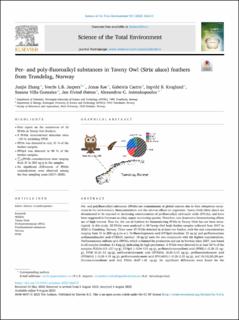| dc.contributor.author | Zhang, Junjie | |
| dc.contributor.author | Jaspers, Veerle Leontina B | |
| dc.contributor.author | Røe, Jonas | |
| dc.contributor.author | Varela, Gabriela Castro | |
| dc.contributor.author | Kroglund, Ingvild Buran | |
| dc.contributor.author | Villa Gonzalez, Susana | |
| dc.contributor.author | Østnes, Jan Eivind | |
| dc.contributor.author | Asimakopoulos, Alexandros | |
| dc.date.accessioned | 2024-03-20T09:12:18Z | |
| dc.date.available | 2024-03-20T09:12:18Z | |
| dc.date.created | 2023-09-01T12:15:35Z | |
| dc.date.issued | 2023 | |
| dc.identifier.citation | Science of the Total Environment. 2023, 903 1-10. | en_US |
| dc.identifier.issn | 0048-9697 | |
| dc.identifier.uri | https://hdl.handle.net/11250/3123291 | |
| dc.description.abstract | Per- and polyfluoroalkyl substances (PFASs) are contaminants of global concern due to their ubiquitous occurrence in the environment, bioaccumulation and the adverse effects on organisms. Tawny Owls (Strix aluco) are documented to be exposed to increasing concentrations of perfluoroalkyl carboxylic acids (PFCAs), and have been suggested in literature as a key raptor monitoring species. Therefore, non-destructive biomonitoring efforts are of high interest. Thus far, the use of feathers for biomonitoring PFASs in Tawny Owls has not been investigated. In this study, 32 PFASs were analyzed in 49 Tawny Owl body feather samples collected from 2017 to 2020 in Trøndelag, Norway. There were 30 PFASs detected in at least one feather, with the sum concentrations ranging from 31 to 203 ng/g (w.w.). Perfluoroheptanoic acid (PFHpA) (median: 33 ng/g) and perfluorooctane sulfonamidoacetic acid (FOSAA) (median: 18 ng/g) were the two compounds with the highest concentrations. Perfluorooctane sulfonic acid (PFOS), which is banned for production and use in Norway since 2007, was found in all samples (median: 4.14 ng/g), indicating its high persistence. 8 PFASs were detected in at least 50 % of the samples: FOSAA (11–127 ng/g), PFHpA (<0.04–115 ng/g), perfluorobutanesulfonic acid (PFBS) (<0.28–21 ng/g), PFOS (0.23–13 ng/g), perfluorotridecanoic acid (PFTrDA) (0.24–5.15 ng/g), perfluorododecanoic acid (PFDoDA) (<0.28–4.45 ng/g), perfluoroundecanoic acid (PFUnDA) (<0.28–2.33 ng/g), and 1H,1H,2H,2H-perfluorooctanesulfonic acid (6:2 FTSA) (0.07–1.01 ng/g). No significant differences were found for the concentrations of PFASs between calendar years and locations, but a slight increase could be observed in the sum concentration of PFASs (Ʃ32PFASs) over the sampling years. As Tawny Owls are residential owls that usually do not cover great distances, their feathers can be used as a potential alternative matrix for future biomonitoring studies. To our knowledge, this is the first study on the occurrence of 32 PFASs investigated in feathers of a Tawny Owl population. | en_US |
| dc.language.iso | eng | en_US |
| dc.publisher | Elsevier | en_US |
| dc.rights | Navngivelse 4.0 Internasjonal | * |
| dc.rights.uri | http://creativecommons.org/licenses/by/4.0/deed.no | * |
| dc.title | Per- and poly-fluoroalkyl substances in Tawny Owl (Strix aluco) feathers from Trøndelag, Norway | en_US |
| dc.title.alternative | Per- and poly-fluoroalkyl substances in Tawny Owl (Strix aluco) feathers from Trøndelag, Norway | en_US |
| dc.type | Journal article | en_US |
| dc.type | Peer reviewed | en_US |
| dc.description.version | publishedVersion | en_US |
| dc.source.pagenumber | 1-10 | en_US |
| dc.source.volume | 903 | en_US |
| dc.source.journal | Science of the Total Environment | en_US |
| dc.identifier.doi | 10.1016/j.scitotenv.2023.166213 | |
| dc.identifier.cristin | 2171643 | |
| cristin.ispublished | true | |
| cristin.fulltext | original | |
| cristin.qualitycode | 2 | |

